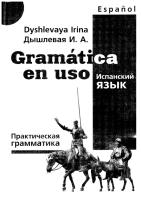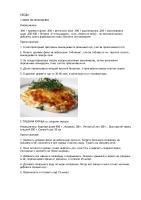Inconel 625 PDF [PDF]
The outstanding and versatile corrosion resistance of INCONEL alloy 625 under a wide range of temperatures and pressures
39 0 420KB
Papiere empfehlen
![Inconel 625 PDF [PDF]](https://vdoc.tips/img/200x200/inconel-625-pdf.jpg)
- Author / Uploaded
- Erick Olavarria
Datei wird geladen, bitte warten...
Zitiervorschau
The outstanding and versatile corrosion resistance of INCONEL alloy 625 under a wide range of temperatures and pressures is a primary reason for its wide acceptance in the chemical processing field. Because of its ease of fabrication, it is made into a variety of components for plant equipment. Its high strength enables it to be used, for example, in thinner-walled vessels or tubing than possible with other materials, thus improving heat transfer and saving weight. Some applications requiring the combination of strength and corrosion resistance offered by INCONEL alloy 625 are bubble caps, tubing, reaction vessels, distillation columns, heat exchangers, transfer piping, and valves. In the nuclear field, INCONEL alloy 625 may be used for reactor-core and control-rod components in nuclear water reactors. The material was selected because of its high strength, excellent uniform corrosion resistance, resistance to stress cracking and excellent pitting resistance in 500°-600°F water. Alloy 625 is also being considered in advanced reactor concepts because of its high allowable design strength at elevated temperatures, especially between 1200°-1400°F. The properties given in this bulletin, results of extensive testing, are typical of the alloy but should not be used for specification purposes. Applicable specifications appear in the last section of this publication. Table 1 - Limiting Chemical Composition, % Nickel Chromium Iron Molybdenum Columbium (plus Tantalum) Carbon Manganese Silicon Phosphorus Sulfur Aluminum Titanium Cobalt a
58.0 min. 20.0-23.0 5.0 max. 8.0-10.0 3.15-4.15 0.10 max. 0.50 max. 0.50 max. 0.015 max. 0.015 max. 0.40 max. 0.40 max. 1.0 max.
a
If determined
Publication Number SMC-063 Copyright © Special Metals Corporation, 2002 (Nov 02) INCONEL and INCOLOY are trademarks of the Special Metals Corporation group of companies. The data contained in this publication is for informational purposes only and may be revised at any time without prior notice. The data is believed to be accurate and reliable, but Special Metals makes no representation or warranty of any kind (express or implied) and assumes no liability with respect to the accuracy or completeness of the information contained herein. Although the data is believed to be representative of the product, the actual characteristics or performance of the product may vary from what is shown in this publication. Nothing contained in this publication should be construed as guaranteeing the product for a particular use or application.
®
INCONEL® nickel-chromium alloy 625 is used for its high strength, excellent fabricability (including joining), and outstanding corrosion resistance. Service temperatures range from cryogenic to 1800°F. Composition is shown in Table 1. Strength of INCONEL alloy 625 is derived from the stiffening effect of molybdenum and columbium on its nickel-chromium matrix; thus precipitation-hardening treatments are not required. This combination of elements also is responsible for superior resistance to a wide range of corrosive environments of unusual severity as well as to high-temperature effects such as oxidation and carburization. The properties of INCONEL alloy 625 that make it an excellent choice for sea-water applications are freedom from local attack (pitting and crevice corrosion), high corrosion-fatigue strength, high tensile strength, and resistance to chloride-ion stress-corrosion cracking. It is used as wire rope for mooring cables, propeller blades for motor patrol gunboats, submarine auxiliary propulsion motors, submarine quick-disconnect fittings, exhaust ducts for Navy utility boats, sheathing for undersea communication cables, submarine transducer controls, and steam-line bellows. Potential applications are springs, seals, bellows for submerged controls, electrical cable connectors, fasteners, flexure devices, and oceanographic instrument components. High tensile, creep, and rupture strength; outstanding fatigue and thermal-fatigue strength; oxidation resistance; and excellent weldability and brazeability are the properties of INCONEL alloy 625 that make it interesting to the aerospace field. It is being used in such applications as aircraft ducting systems, engine exhaust systems, thrust-reverser systems, resistance-welded honeycomb structures for housing engine controls, fuel and hydraulic line tubing, spray bars, bellows, turbine shroud rings, and heat-exchanger tubing in environmental control systems. It is also suitable for combustion system transition liners, turbine seals, compressor vanes, and thrust-chamber tubing for rocket motors.
INCONEL alloy 625
www.specialmetals.com
INCONEL ® alloy 625
Physical Constants and Thermal Properties Figure 1 - Thermal expansion at low temperatures
Some physical constants and thermal properties of INCONEL alloy 625 are shown in Tables 2 and 3. Low-temperature thermal expansion, based on measurements made by the National Bureau of Standards, is shown in Figure 1. Elevated-temperature modulus of elasticity data are given in Table 4.
8
Coefficient of expansion, in./in./°Fx10-6
7
Table 2 - Physical Constants Density, gram/cc lb/cu in. Melting Range, F Calculated Specific Heat, a Btu/lb/ F 0F 70 F 200 F 400 F 600 F 800 F 1000 F 1200 F 1400 F 1600 F 1800 F 2000 F Permeability (75 F, 200 oersted) Curie Temperature, F
8.44 0.305 2350-2460 0.096 0.098 0.102 0.109 0.115 0.122 0.128 0.135 0.141 0.148 0.154 0.160 1.0006

![Dinamica structurilor mentalitare [1st edition]
973-697-625-4](https://vdoc.tips/img/200x200/dinamica-structurilor-mentalitare-1st-edition-973-697-625-4.jpg)







